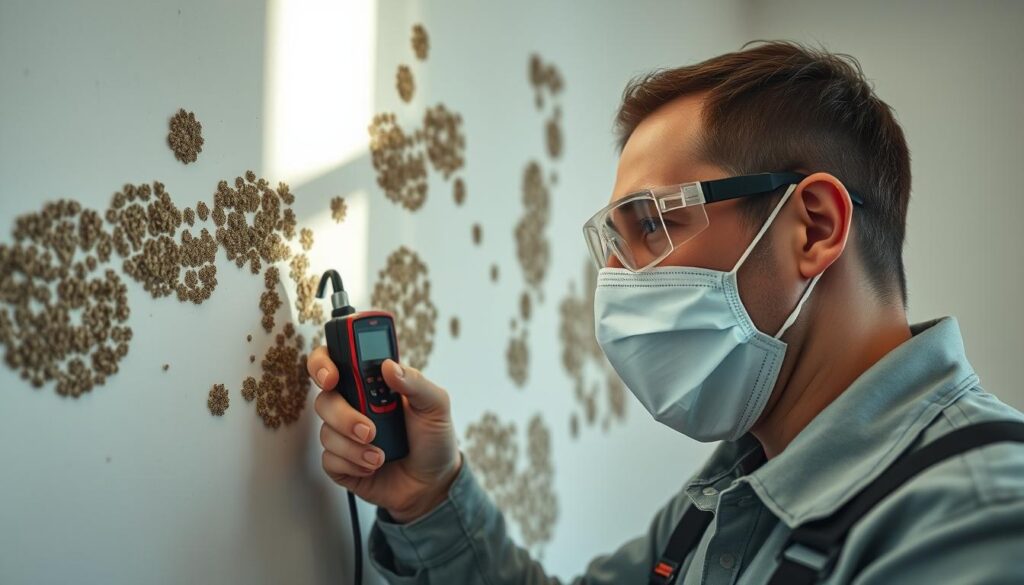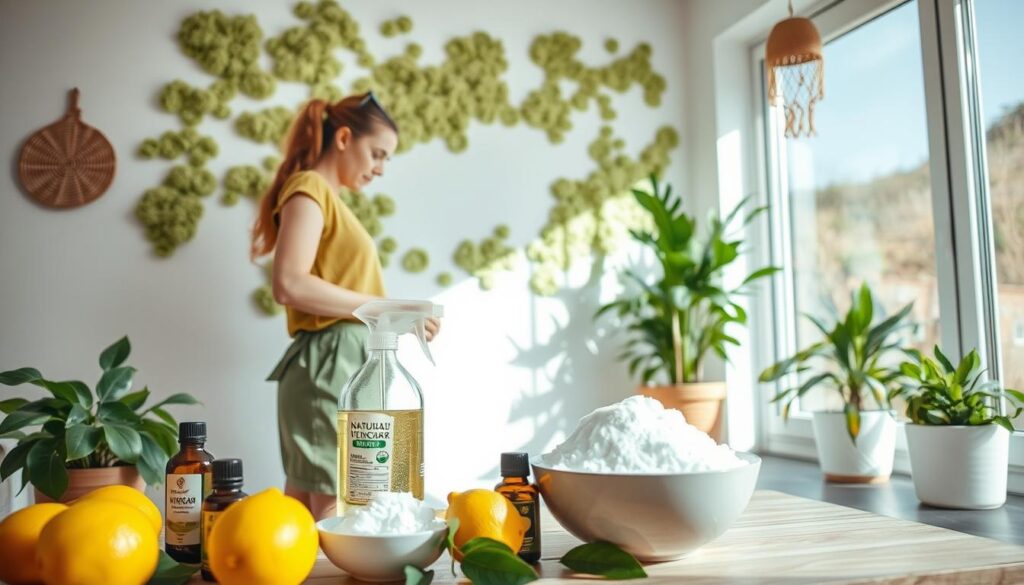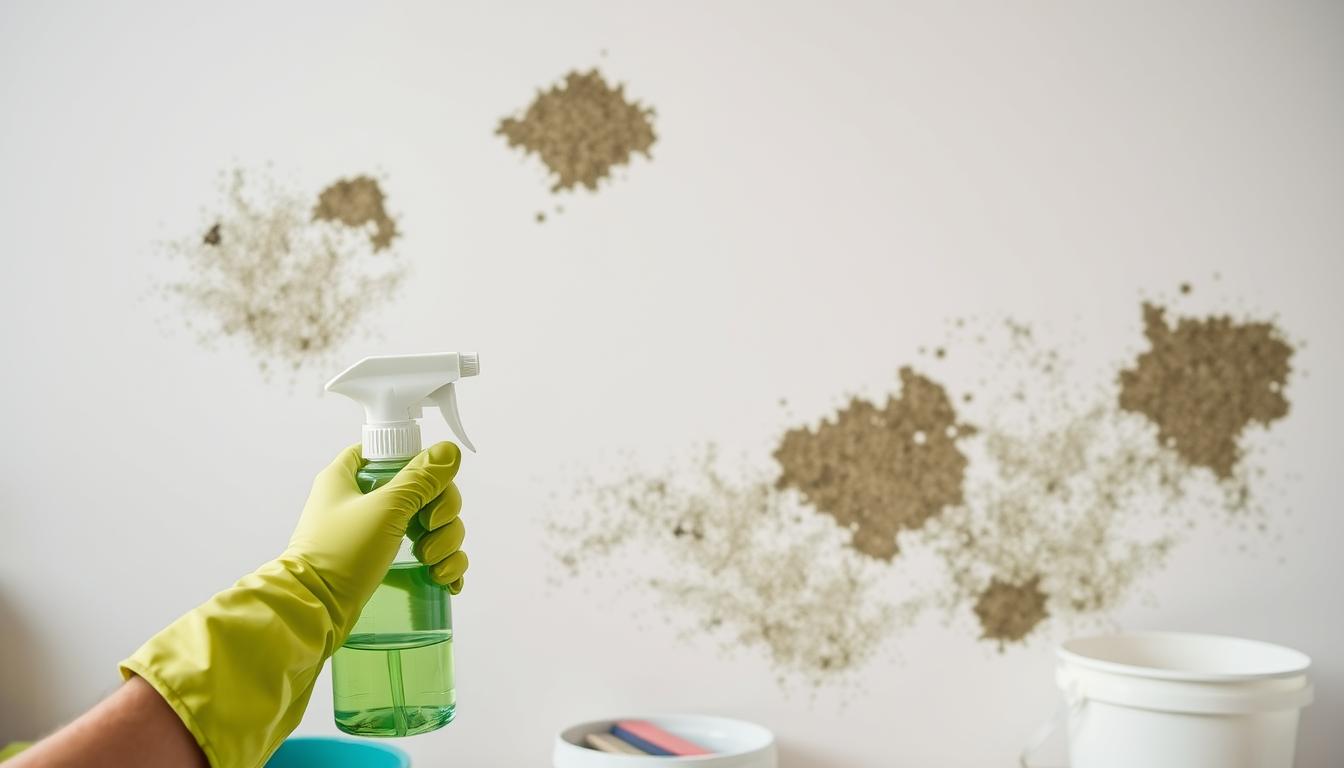How to Remove Mould From a Wall
In the United States, mold on walls can signal bigger problems like water leaks. Mold often grows on walls, ceilings, and floors where moisture is not well-managed. Basements, shower walls, and windowsills are common places for mold to thrive.
This mold can be harmful, causing allergies, asthma, and breathing issues. It’s especially dangerous for kids, the elderly, and people with weak immune systems or respiratory problems.
If you see mold on your walls, you must act fast. This guide will show you simple DIY ways to remove mold using common items and expert methods. But, for big mold problems, the U.S. Environmental Protection Agency suggests getting a professional to handle it. This is especially true for mold that covers more than 10 square feet.
Key Takeaways
- Mold on walls can be a sign of larger moisture issues in the home.
- Mold can cause respiratory problems, especially for vulnerable groups.
- Small mold colonies can be addressed with DIY cleaning methods.
- Larger mold infestations may require professional remediation.
- Proper safety equipment is essential when removing mold.
Understanding Different Types of Household Mould
Mould is a common problem in many homes. It comes in various shapes, sizes, and colors. From black mould to white, blue, and green, each type has its own traits and health risks.
Black Mould and Its Characteristics
Black mould, also known as Stachybotrys Chartarum, is a serious concern. It grows in moist areas like leaky pipes or flooded basements. It can produce harmful toxins that cause respiratory issues, immune problems, and even memory loss.
White, Blue, and Green Mould Variations
While black mould is well-known, other types are also harmful. White mould can cause allergic reactions and breathing problems. Blue and green mould, found in humid places, can lead to breathing issues and skin irritation.
Common Areas for Mould Growth
Mould grows in moist areas around the home. Basements, shower walls, and areas with water damage are common spots. It’s important to tackle these areas to stop mould growth and keep your family healthy.
| Mould Type | Characteristics | Health Risks | Common Growth Areas |
|---|---|---|---|
| Black Mould (Stachybotrys Chartarum) | Thrives in areas with excessive moisture, produces harmful mycotoxins | Respiratory issues, immune system disorders, memory loss | Leaky pipes, flooded basements, poorly ventilated bathrooms |
| White Mould | Found in cool, damp environments like basements | Allergic reactions, respiratory problems | Basements, damp areas |
| Blue and Green Mould | Typically appear in bathrooms and other humid areas | Respiratory distress, skin irritation | Bathrooms, humid areas |
Knowing about different mould types is key to fixing the problem. By identifying the mould and fixing moisture issues, homeowners can keep their families safe and healthy.
Essential Safety Equipment for Mould Removal
Removing mold can be tough, but safety is key. As a mold inspection pro, I always stress the importance of protective gear. It’s vital for a safe and effective mold removal.
The essential safety equipment for mold removal includes:
- Respirators, such as N-95 respirators, which filter out at least 95% of airborne particles, including mold spores.
- Protective gloves, typically made of nitrile or latex, to safeguard your hands from mold and cleaning chemicals.
- Goggles or safety glasses and face shields to shield your eyes and face from mold exposure.
- Coveralls or protective clothing made of materials like Tyvek or microporous film laminate (MFL) to create a barrier against mold spores.
- Waterproof boots to prevent the spread of mold and protect your feet from exposure.
Wear these items throughout the mold removal process. Even brief exposure can cause health issues or spread mold. For big mold jobs, use air movers, dehumidifiers, and air scrubbers. They help keep air clean and control humidity.
By taking the right safety steps and using protective gear, you can safely remove mold. Always choose caution for your health and safety.

| Protective Gear | Purpose |
|---|---|
| N-95 Respirator | Filters out at least 95% of airborne particles, including mold spores |
| Nitrile or Latex Gloves | Protect hands from mold and cleaning chemicals |
| Goggles and Face Shields | Shield eyes and face from mold exposure |
| Coveralls and Boots | Create a barrier against mold spores and prevent their spread |
Proper protective equipment is key for safe mold removal. By focusing on safety, you can successfully remove mold and avoid health problems.
How to Remove Mould From a Wall
Removing mould from walls can be tough, but it’s doable with the right tools and methods. The first step is to fix the moisture problem. Then, you can get rid of the mould you see.
Creating Effective Cleaning Solutions
To make a strong mold cleaner, mix one tablespoon of dishwashing liquid, 1/2 cup of chlorine bleach, and one cup of warm water. This mix is great at breaking down and removing mould from walls.
Step-by-Step Cleaning Process
- Begin by spraying or using a sponge to apply the cleaning solution to the wall, starting from the bottom.
- Let the solution sit on the wall for a few minutes. This lets it get deep into the mould.
- Wash the wall with clean water to remove all the solution.
- Use a clean cloth to dry the wall or let it air-dry completely.
Dealing with Stubborn Mould Stains
If the mould stains are hard to get rid of, you might need to clean again with a new solution. Try using distilled white vinegar or hydrogen peroxide for smaller spots. Always test a small area first to make sure it won’t harm the wall.
“Moisture control is key in preventing mold growth on walls; excess moisture encourages mold development.”
By following these steps and using the right cleaners, you can remove mould from walls. This is a big step towards a healthier, mould-free home.
Natural vs Chemical Cleaning Solutions
Homeowners often wonder whether to use natural or chemical cleaners to remove mold from walls. The choice depends on the mold’s size and personal preference.
For small mold problems, distilled white vinegar or hydrogen peroxide work well. Vinegar breaks down mold, and hydrogen peroxide kills it and lightens stains. These natural options might need more effort but are good for those who prefer eco-friendly solutions.
Chemical mold removers, often with bleach-like ingredients, are stronger for big mold problems. They are effective for large mold growths. But, it’s crucial to follow the instructions and be safe when using these cleaners.
“Mold infestation larger than 3ft x 3ft square is considered a major issue that requires professional services for mitigation and removal.”
When deciding between natural and chemical cleaners, think about the mold’s size and your preference. Natural methods are better for small mold, while chemicals are stronger for big problems. The key is to safely and effectively remove the mold, no matter the cleaner used.

Addressing Mould on Different Wall Surfaces
Dealing with mould on walls can be tough. But, the right approach depends on the wall type. Whether it’s drywall, painted walls, concrete, or basement walls, knowing how to clean is key. This helps remove mould and stops it from coming back.
Cleaning Drywall and Painted Walls
For drywall or painted walls, be careful not to soak them too much. This could harm the paper or paint. Instead, gently scrub with a mould-killing solution. Make sure the area dries completely to stop mould from coming back.
If you have painted walls, you might need to use a stain-blocking primer. This helps prevent the mould stain from showing again.
Treating Concrete and Basement Walls
Concrete and basement walls are different. They’re more porous, so they need a deeper clean. Use a scrub brush and a bleach solution on these areas. Pay extra attention to cracks and crevices where mould likes to hide.
In basements, using a dehumidifier helps keep humidity levels right. This stops mould from growing back. If mould keeps coming back on porous surfaces, like ceiling tiles, you might need to replace them.
It’s important to tackle mould on different walls to keep your home safe and healthy. By knowing the right cleaning methods and taking steps to prevent it, you can keep your home mould-free.
Professional vs DIY Mould Removal
There are two ways to deal with mould: you can try it yourself or get a professional. DIY methods work well for small spots, but for bigger problems, experts are best. Professional mold removal companies have the tools and knowledge to handle mould safely.
Mould can be harmful, especially black mold. Experts know how to spot and remove different types. They use special cleaners that kill mould and stop it from coming back.
Trying to remove mould yourself can spread the problem. Without the right gear, you could get sick. DIY methods might not fix the moisture issues that cause mould to grow back.
DIY might save money for small areas, but pros are more thorough. Professional mold remediation companies like [https://www.moldremediatorsusa.com/locations/] do detailed tests to make sure mould is gone for good.
“Mold remediation professionals are equipped with the necessary tools and expertise to safely and effectively remove mold from your home, ensuring a healthier living environment.”
Choosing between DIY and professional help depends on the mould problem’s size and severity. For big or health-risk mould, it’s safer to call a professional. They ensure a job well done.
Preventing Future Mould Growth
Keeping your home healthy is key to stop mold from coming back. By controlling moisture and improving air flow, you can fight mold growth. This keeps your home safe.
Controlling Indoor Humidity
Mold loves damp places, so keeping humidity under 60% is important. Use dehumidifiers in wet areas like basements and bathrooms. Fix any leaks quickly to avoid too much moisture.
Improving Ventilation
Good air flow is essential to stop mold. Make sure bathrooms, kitchens, and laundry rooms have enough air. Use exhaust fans or open windows to remove moist air and improve air flow.
- Install exhaust fans in bathrooms, kitchens, and laundry rooms to remove moist air
- Open windows regularly to increase air circulation and reduce humidity
- Use dehumidifiers in damp areas to maintain indoor humidity below 60%
- Promptly fix any leaks or water intrusion to eliminate excess moisture
In basements, use waterproof sealant before painting to stop moisture. Clean and maintain wet areas like bathrooms and kitchens often to stop mold.
By using these mold prevention, damp proofing, and moisture control tips, you can keep your indoor air quality good. This protects your home from mold in the future.
Signs of Serious Mould Infestation
As a homeowner, it’s important to watch for signs of serious mould. Mould can be harmful, especially for those with allergies or weakened immune systems. Look for dark patches on walls or ceilings as a clear sign.
A musty smell can also mean mould is around, even if you can’t see it. This smell often comes from places with lots of moisture, like bathrooms or basements. Water damage, like stains on walls, can also point to mould.
Your health can also give clues about mould. Headaches, breathing problems, or allergies might mean you’re exposed. If you feel better outside your home, it could mean mould is the culprit. Big mould problems need a pro to fix, as explained in this useful guide.
FAQ
What are the different types of household mould and their characteristics?
Black mould thrives in moist areas and can release harmful toxins. White mould is common in cool, damp places like basements. Blue and green mould often shows up in humid spots, like bathrooms.
Common places for mould include basements, shower walls, and areas with water damage. High humidity also attracts mould.
What safety equipment is necessary for mould removal?
You’ll need protective gloves, eyewear, and a face mask, like an N-95 respirator. Wear old clothes that can be easily thrown away. Open windows or use fans for good air flow.
For big jobs, use a circulating fan and a stepladder to reach high spots.
How do I create an effective cleaning solution for mould removal?
Mix one tablespoon of dishwashing liquid, 1/2 cup of chlorine bleach, and one cup of warm water. Spray or sponge the solution on the wall, starting from the bottom. Let it air-dry.
For tough stains, apply a new solution and repeat.
What are the advantages and disadvantages of using natural vs chemical cleaning solutions?
Chlorine bleach kills mould spores well, but natural options like vinegar or hydrogen peroxide work for small infestations. Vinegar breaks down mould, while hydrogen peroxide kills it and lightens stains.
Natural solutions might need more applications and scrubbing. Chemical removers, similar to bleach, are stronger for big problems.
How do I approach mould removal on different wall surfaces?
On drywall, avoid too much water to prevent damage. Use a soft scrub and let it dry well. Painted walls might need a stain-blocking primer after cleaning.
For concrete and basement walls, scrub with a bleach solution. Basements should have a dehumidifier to stop mould.
When should I consider professional mould remediation?
DIY is okay for small areas (less than 10 square feet) and non-porous surfaces. But, for big infestations or hard-to-reach places, get a pro. They have the right tools and know-how.
How can I prevent future mould growth in my home?
Keep moisture under control and air well-ventilated. Use dehumidifiers in damp spots and keep humidity below 60%. Fix leaks fast and ensure good air flow in wet areas.
Improve air circulation everywhere. In basements, use a waterproof sealant before painting. Regularly clean and maintain wet areas like kitchens and bathrooms.
What are the signs of a serious mould infestation?
Look for visible mould, especially black or dark patches. A musty smell often means hidden mould. Watch for water damage signs like wall or ceiling discoloration.
Health issues like allergies, breathing problems, or headaches can be mould-related. Soft or damp walls may also indicate mould.




